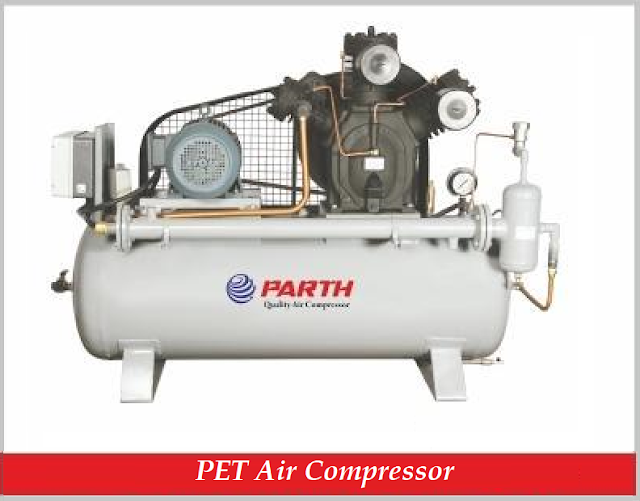Polyethylene
Terephthalate (PET) compressor systems for bottling plants have a
history of ages. Started in 1970 with smaller and larger compressor
units, they were previously available in types such as air-cooled and
water-cooled compressors and boosters. The range of air blow pressure
applied to these compressors has changed from 250 to 650 psi and higher.
With evolution and trend, to create intricate, high-speed bottle
designs, manufacturers are keen to promote energy conservation and
reduce blow pressure.
Types of blow air compressors
Single-Stage Boosters with 10/500 CFM
- Uses inlet air depending on pressure from 125-175 psi
- Available in both non-lubricated and lubricated configurations
- The Service life of 10-15 years
Single-Stage Boosters with 600/2,000 CFM
- Uses inlet air of 125 psi
- Costly than other types
- The Service life of 20-30 years
Three-Stage Air-cooled piston
- Moderately efficient and cost-effective
- Available in lubricated configuration
- The Service life of 10-12 years
Three-Stage Water-cooled Piston
- Water-cooled and oil-free
- Moderate maintenance costs
- The Service life of 20-30 years
Four-stage High-Pressure Centrifugal with 1,800/5,000 CFM
- Oil-free and power cost-inefficient
- Low maintenance costs
- The Service life of 10-15 years
How to Define Blow Air Requirements for Your Purpose of Application
Once we know the availability and type of equipment, here are some key factors to consider while defining blow air requirements.
1. Plant Type/Purpose
Consider your compressor plant plan, whether it is a startup or continued work on the existing facility. It would help if you always kept it simple when it comes to accessibility and mobility.
2. Project Budget and Lifespan
Project budget and expense depend a lot on the business plan and tenure. For a 5 to 7-year business plan, you can consider the three-stage PET air booster. While for the business plans with longer terms, you can view the water-cooled PET boosters as per the budget constraints.
3. Bottle Design and Type
Bottles for liquid storage like water with simple designs have lower pressure requirements than those with food and pharma bottles. Depending on the complexity and type of compressor, the market determines the structure of bottles.
4. Hours of operation
The hours of operation of the equipment differ annually. For smaller air-cooled units and small bottle manufacturers, single shift operation can take up to 2,000 hours. Simultaneously, the production of larger water-cooled companies takes up to 4k to 6k hours annually.
5. Air Quality
Most of the startup bottle blowing companies perform filtration processes with a three-stage piston or booster. Air filtration is a three-stage process where the final stage involves carbon filtration to remove taste and odor. Thus, it is crucial to keep changing the filter regularly to maintain the air quality standards that adhere to ISO requirements.
6. Blow Pressure
The blow pressure requirement is one of the critical factors while considering the PET air compressor or boosters. Machine speed and design of the liquid bottle are primary factors here. When the pressure is higher, more heat is generated in the compressor: the pressure and heat result in higher power costs and maintenance costs.
7. Space for Compressor Installation
Consider the space, positioning of installation of the compressor system, and other factors as:
● Ventilation
● Future Expansion
● Access and
● Overhead Gantry
8. Maintenance and Backup to handle downtime issues
The PET high pressure compressors require continuous maintenance and intensive reporting. It would be best if you had a trained maintenance team to record and prevent the production plants' downtime. It is also necessary to perform timely maintenance checks at hour intervals of 2000, 4000, and 6000 hours.
Most companies with bottling plants consider a rebuilt or old system as a backup. They think having 100% backup ready for facilities at remote locations or production plants. It is an economical and smart decision about what will be the uptime of the existing system.
The prime underlying problems are related to factors like volume and pressure. As the system ages, the pressure declines. Such cases require professional work like that of a detective to test whether the cause of the problem - piping changes or the booster or compressor. The success of the whole entity largely depends on the bottle design, size, and production rate. We suggest you consider all the points while considering to choose the PET air compressor.


Complete Information about pet Blowing Compressor its feature and type .That type of Content is Good. Keep it up. We are also provide PET blowing compressor
ReplyDelete